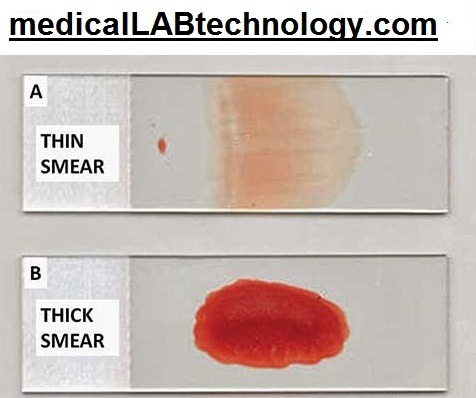The perfect blood smear technique is important for the microscopic study of microorganisms like bacteria, fungi, and other parasites like Plasmodium species, Leishmania species, and others.
Ideal blood film is necessary for identifying the specific types of anemia, whether it is microcytic anemia, microcytic hypochromic, or normocytic anemia.
What are the uses of peripheral blood smears?
- Blood film is used for Differential leucocyte count (DLC).
- Identification and assessments of various cell counts.
- Study of Red blood cell (RBC) morphology for the classification of various types of anemia (microcytic, macrocytic, normocytic ).
- It is used to study white blood cells (WBC) for the diagnosis of leukemia and other WBC diseases.
- Study of Platelets, for diagnosis of platelet diseases.
- It is used to study bone marrow disease.
What are the requirements for Perfect blood smear preparation?
Here are the requirements for a blood smear.
- Pre-clean glass slide for smear preparation.
- Spreader. It is a small piece of slide or coverslip. It should be narrower than a glass slide. The edge should be thin, smooth, and polished. It is used to spread the blood on slides.
Note: Tough coverslip of the Neubauer chamber can also use as a spreader.
How to prepare a perfect blood smear in 4 Steps?
A blood film or blood smear is prepared in 4 steps.
- First place a small drop of blood, 1 cm away from one side of the slide.
- In the next step, place the spreader in front of the blood drop at an angle of 450. Move it back, so that it touches the blood. Blood will spread along the margin in contact with the slide of the spreader by capillary mechanism.
- Push the spreader forward along the length of the slide with rapid but smooth and straight movement.
- Allow the smear to dry in the air.
What are the 6 Characteristics of an ideal blood smear?
- The smear should cover half-length of the slide.
- It should be narrower than the glass slide.
- It should be free from bubbles, streaks, and holes.
- The smear should end at a smooth, straight, and slightly curved end.
- It should be thin enough to yield at least x10 low power field where no RBC overlap.
What are the 3 common errors in blood smear (blood film defects)?
- A thick film
- A thin film
- Gritty Tail
1. Thick Film Defect (bad faulty blood smear thick)
This defect occurs when the blood drop is too big, the spreading performs quickly, or the angle of the spreader is more than 45 degrees.
2. Thin Film Defect
This error occurs when a small drop of blood is placed on a slide or the Spreader angle is less than 45. It can occur when the spreading speed is too slow.
3. Gritty Tail Defect
It occurs when the spreader is inappropriate, or the spreading speed is too slow.
Note: Some Anticoagulants other than EDTA or high TLC (total leucocytes count) result in gritty tail defects.
Here’s the video of the “Perfect blood smear technique procedure”.
What are the common errors in blood smears?
1). bad faulty blood smear thick
2). Thin blood smear
3). Gritty tail defect
How to remove a gritty Tail Defect from a blood smear?
What are the 2 characteristics of a perfect blood smear?
2. It should be thin enough to yield at least x10 low-power fields where no RBC overlap.
what are the common errors in making a thick and thin blood film?
Thin blood error occurs when a small drop of blood is placed on a slide or the Spreader angle is less than 45. It can occur when the spreading speed is too slow.

